Hal Jespersen's Burgundy Walking Tour, August 2024
This is my (Hal’s) report on my trip to take a walking tour of the wineries of Burgundy. It is the first part of a European trip that is actually centered on a tour from Marseille to Strasbourg in commemoration of the 80th anniversary of Operation Dragoon, the Allied invasion of southern France. That part of the trip is reported separately, here. I arranged the Burgundy tour with a UK company called Grape Escapes.
Wednesday/Thursday, August 7/8 — to Beaune
I found a decent airfare on TAP Air Portugal, SFO to Lisbon, connecting to Lyon. I did not attempt to go through Paris because the Olympics is still underway. The Portuguese don’t have their own business class lounge, so they passed me off to China Airlines. Their lounge is quite small and not nearly as comfortable as the United Polaris lounge I’m accustomed to, but they do have excellent custom-prepared noodles.
The overnight flight went well, but the lie-flat seat wasn’t too comfortable for a guy of my height and the food was really mediocre. I thought I should stay up and try Portuguese cuisine for dinner, but next time I’ll just go right to sleep as I usually do. I spent the flight freaking out because my luggage AirTag showed no contact beyond SFO for 14 hours, but an hour after landing it woke up here, and I was able to monitor it loading onto my flight to Lyon. Lisbon’s Gen. Humberto Delgado airport is sort of a dump, but the TAP Premium lounge beats China Airlines at SFO. Once you get out of the immigration/baggage/underbelly areas there are a lot a nice shops, including a big one specializing in sardines, a local staple Nancy and I enjoyed grilled when we visited Lisbon 23 years ago.
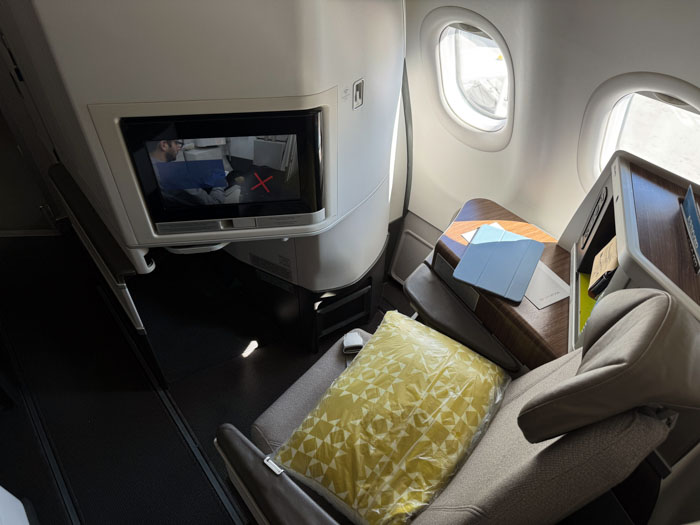
The flight to Lyon was good and I was the only passenger in “premium,” so I was the only one to be given a meal, which was mildly embarrassing. There is a fast tram/train to downtown Lyon called Rhônexpress and I stayed in the Pullman Hotel just steps from the Part-Dieu station. Dinner was a sandwich from a station shop; I had so much airline and lounge food today that I was barely hungry.
Friday, August 9 — Beaune, Aloxe-Corton
I took an SNCF train to Beaune, about an hour and forty minutes, and started on my Grape Escape. A car service picked me up, deposited my bags at the hotel, and drove to the center of the small village of Échrevronne in the southernmost part of the Hautes Côte de Nuits. From here I walked south for about three miles into the Côte de Beaune. I avoided the busiest roads and used a narrow sometimes-dirt farm road up the hill and walked through vineyards almost the whole way, through the town of Pernand-Vergelesses to Aloxe-Corton. I went by a number of Grand Cru white domains including the famous Le Charlemagne and En Charlemagne.

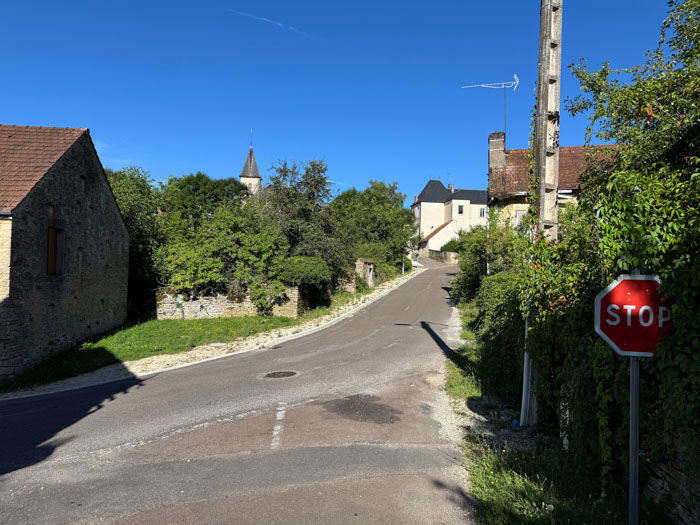
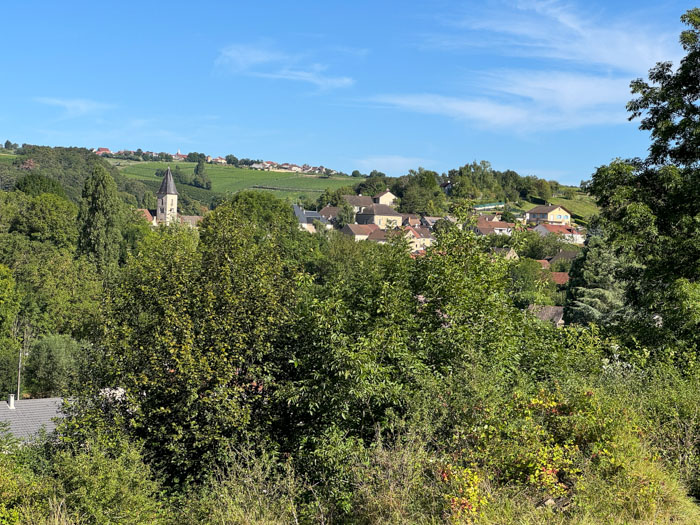
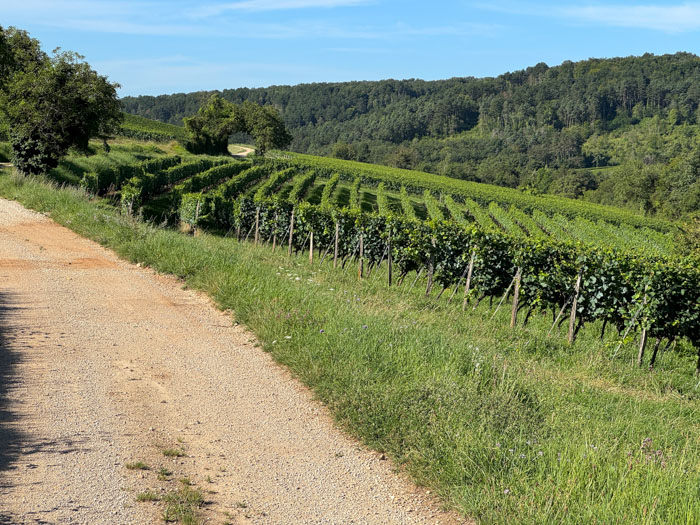


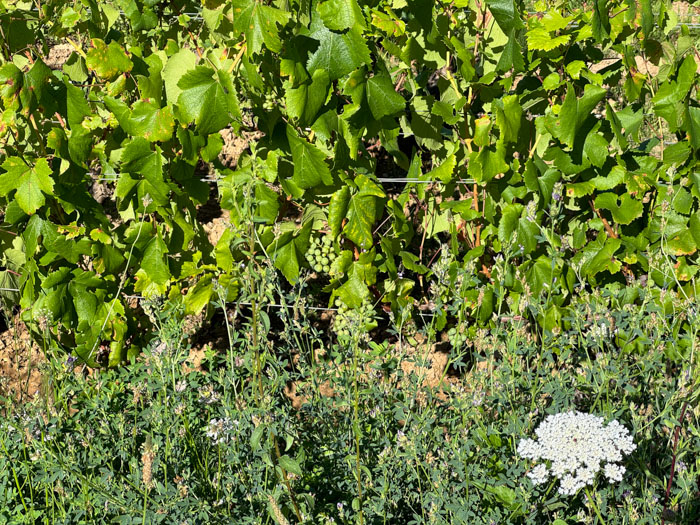
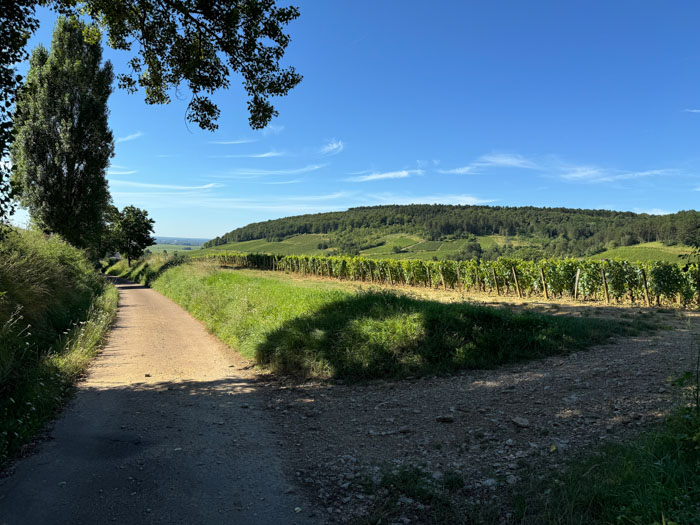
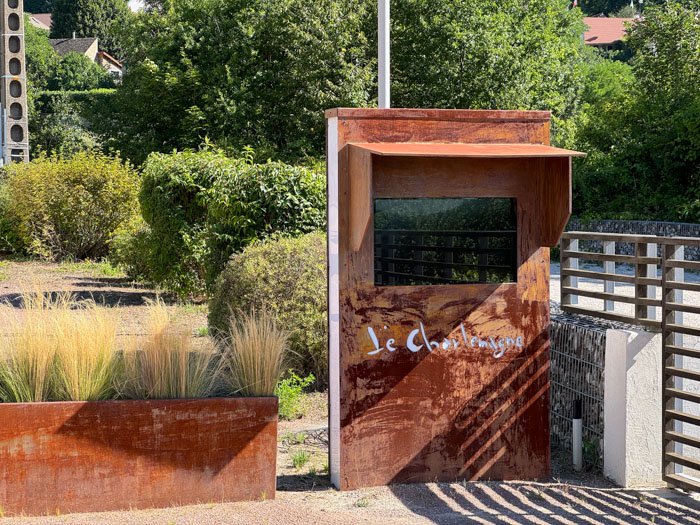
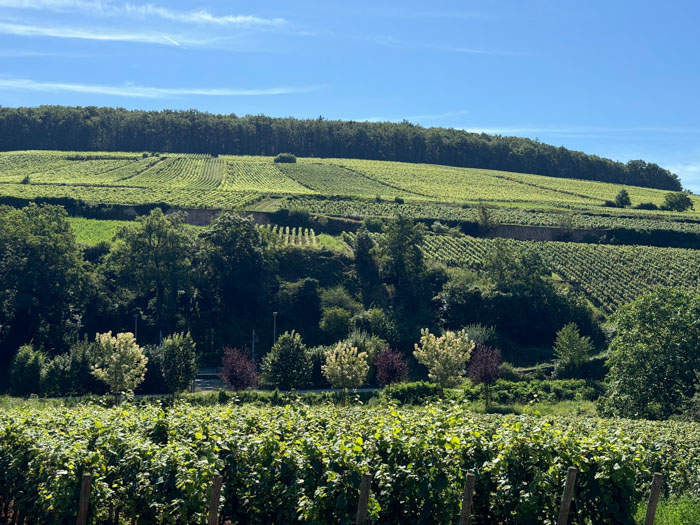
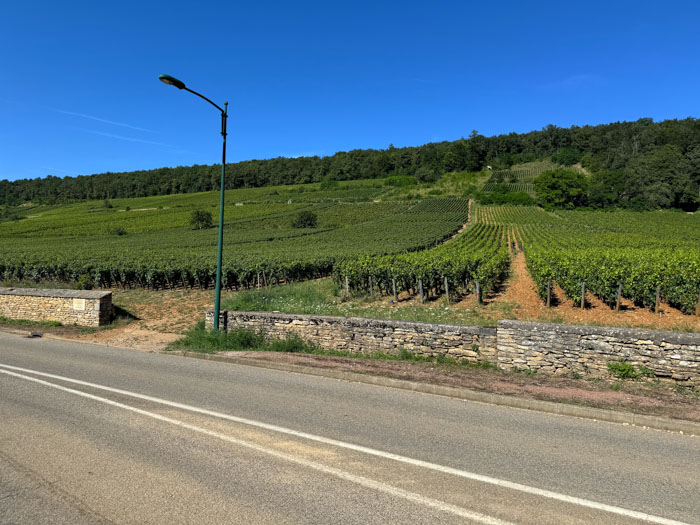
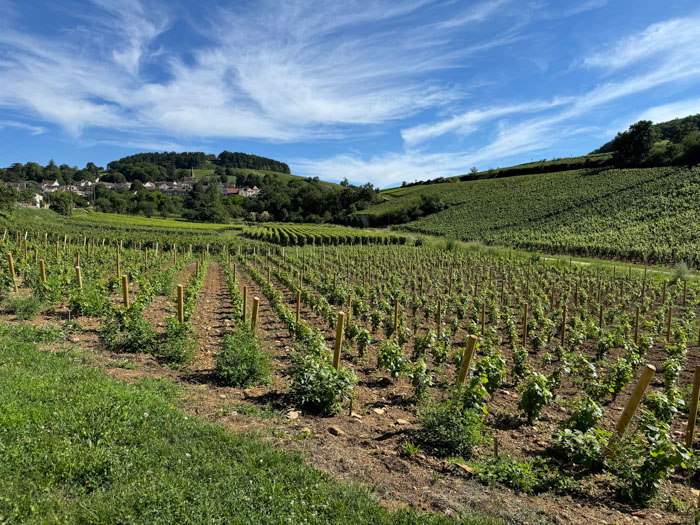
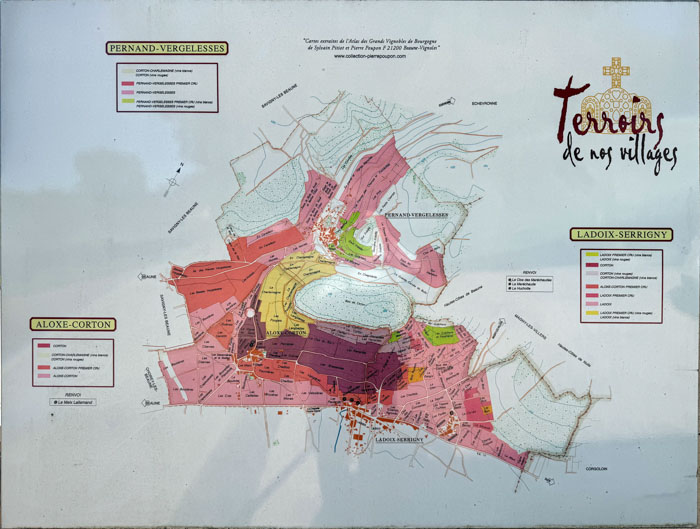
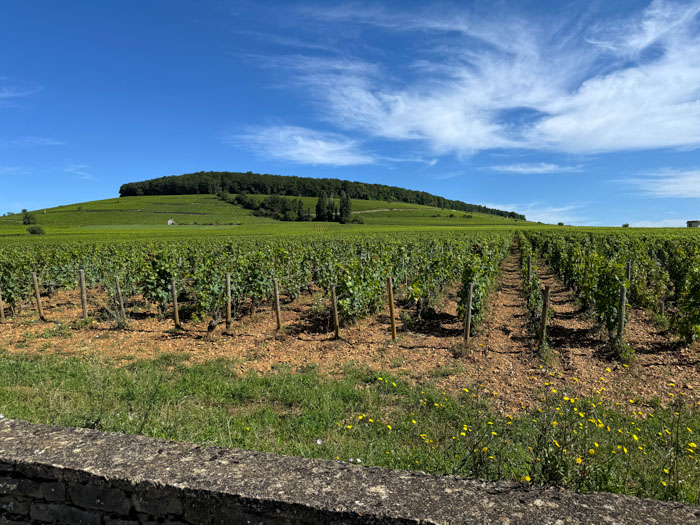
In Aloxe-Corton I had an appointment at Domaine Comte Senard. I was greeted by a young woman named Chloé who was my guide for the experience. We talked about the history of the family, who established the domain in 1857, and saw their Grand Cru “monopole” (owned by one family) vineyard, Clos des Meix, one of a number they have in the vicinity. It has two plots of Pinot Noir separated by a Chardonnay, a result of a narrow stretch of limestone descending from nearby Corton hill (le Bois du Corton). In the cellar we saw the friendly domain cat, Chardonnay, and various stashes of wine, some of which from the 50s have mushrooms growing on them. The cellar has been there since at least the 13th century when the local monks burned the entire town during the Black Plague. There is no wine production at this site. I asked about recent vintages and Chloé said that ‘22 and ‘23 were excellent, but this year may be very problematic because of heavy spring rains.
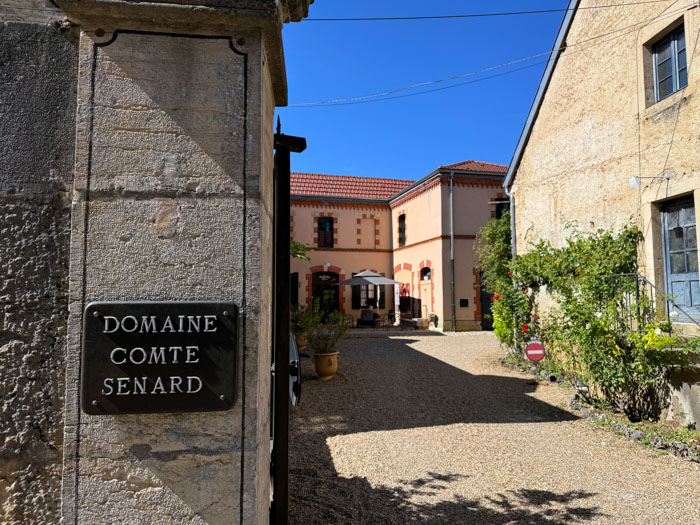
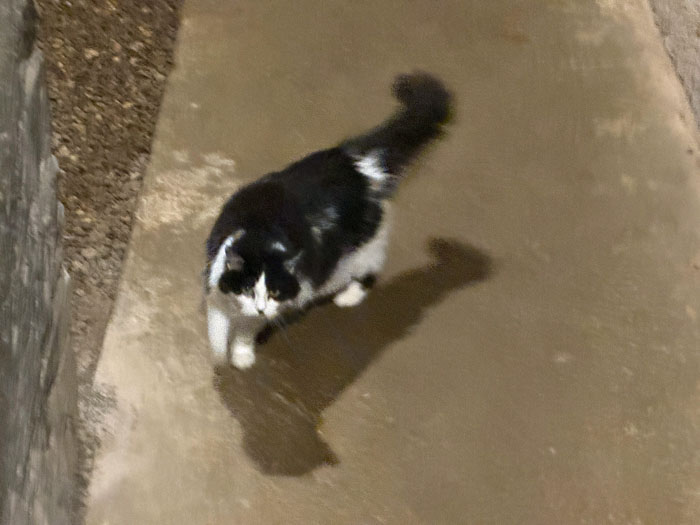


The highlight of the visit was a lunch and tasting. I had gougères (cheese puffs) and ham terrine with a ‘22 Bourgogne (lowest category) Chardonnay (nothing special, but quite different from its California cousin) and a ‘22 Aloxe-Corton Villages Pinot Noir (light and fruity). Next was a substantial and delicious boeuf de Bourgogne and potatoes Dauphinoise with a ‘21 Premier Cru Aloxe-Corton Les Valozières (perfect), and finally a course of three cheeses with ‘14 Grand Cru Corton Clos du Roi, named for Louis XIV, whose doctor prescribed a glass per day. It was deeper and more concentrated than the younger wines; they sell it here for 150€, so it is certainly out of my price range.
I walked around Aloxe-Corton a bit and saw the dramatic Château Corton with its fancy checkered roof and found the Clos du Roi from lunch. Then a three mile hike through more vineyards to Savigny-lès-Beaune for an appointment with Domain Henri de Villamont. They own vineyards totaling about 10 hectares scattered all over the Côte D’Or, but are also negotiants, so they have a really large catalog of wines. The six wines I had in the “prestige” tasting were all from their own properties. The young lady conducting the tasting for me was super knowledgeable and very accommodating to my fatigue from long walks on a hot day (85° with very little shade in the vineyards). There were two whites—‘21 Savigny-lès-Beaune Le Village (Bourgogne) and ‘22 Savigny-lès-Beaune Premier Cru Clos des Guettes. The former was very light and refreshing, the latter more substantial and appropriate for a meal.
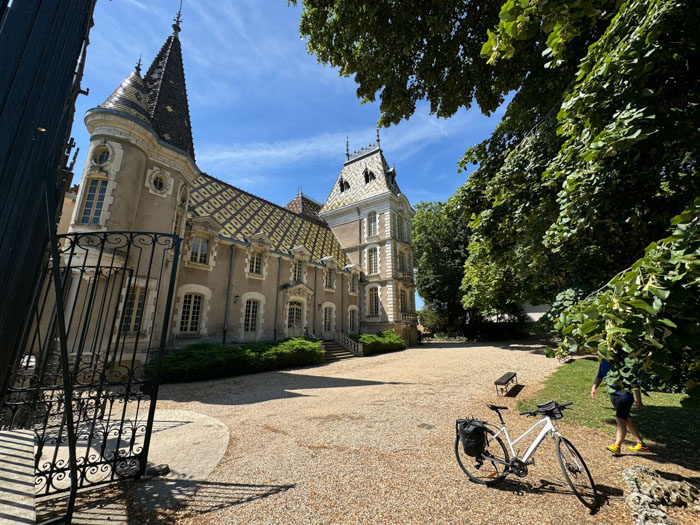

The four reds were two Côtes de Beaune and two Côtes de Nuits. The ‘19 Savigny-lès-Beaune Le Village (Bourgogne) was very light and fruity. The ‘18 Savigny-lès-Beaune Premier Cru Clos des Guettes and ‘20 Chambolle-Musigny Premier Cru Les Baudes were both perfect Pinot Noirs for my taste. The ‘20 Grand Echezeaux Grand Cru (200€) was delicious but because of its youthful tannins, it needs five more years in the cellar. It should be magnificent, as will its price. After a long day, my chauffeur collected me and we returned to the Hotel de la Poste in Beaune, ready to check in. Dinner at the hotel restaurant was very nice in the garden.
Saturday, August 10 — Beaune, Montrachet
I was driven south to Puligny-Montrachet, to a hotel owned by the popular winery and negotiants, Olivier Leflaive Frères. I met Mateo, who took me on a walking excursion through the town of Puligny-Montrachet and the nearby vineyards. We talked about town history, Burgundy wine classifications, the life cycle of grapes in the vineyards, soil composition, vineyard diseases, and pruning practices. I sampled Chardonnay grapes from the vine, which actually tasted like regular green table grapes. We visited a few specific vineyards in which Olivier owns portions (sometimes only a couple of rows), including the Grand Crus of Bâtard-Montrachet and Chevalier-Montrachet, both of which are on slopes of poor soil, meaning the grapes are more stressed and produce small quantities of higher quality.
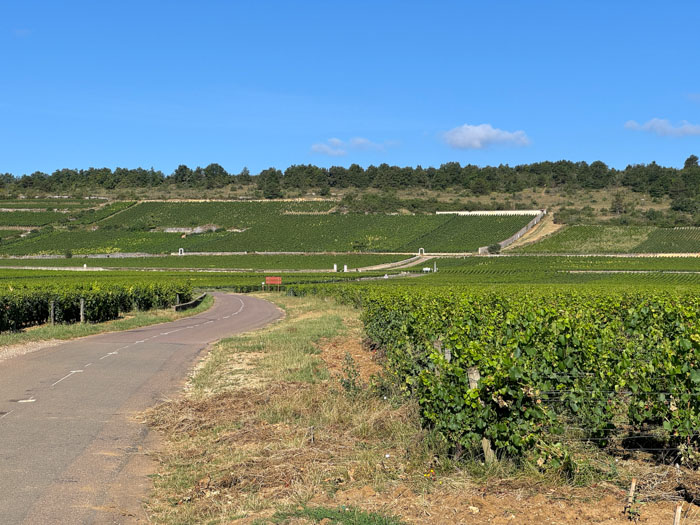
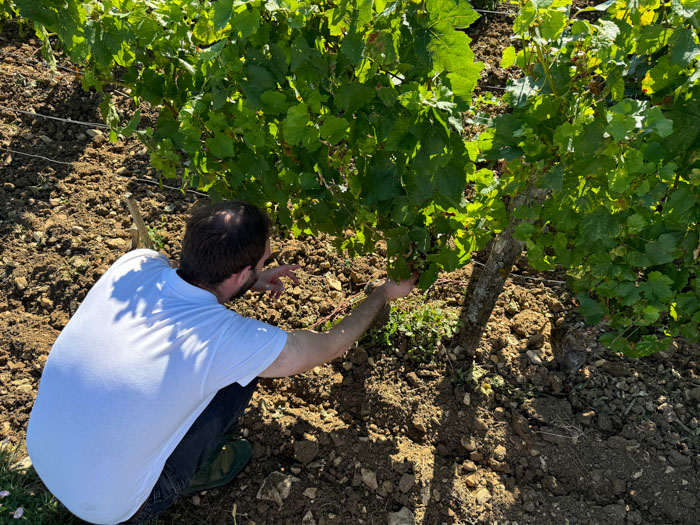
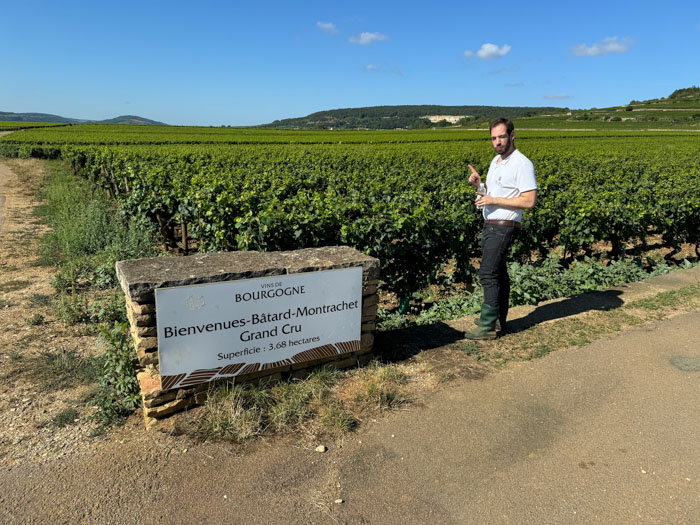
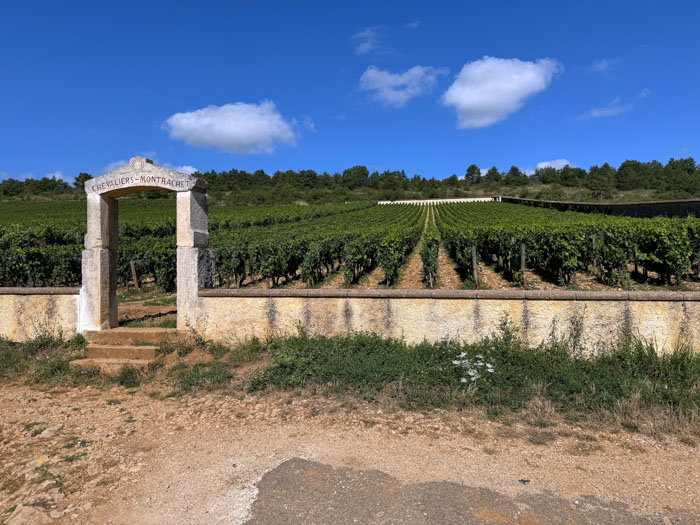
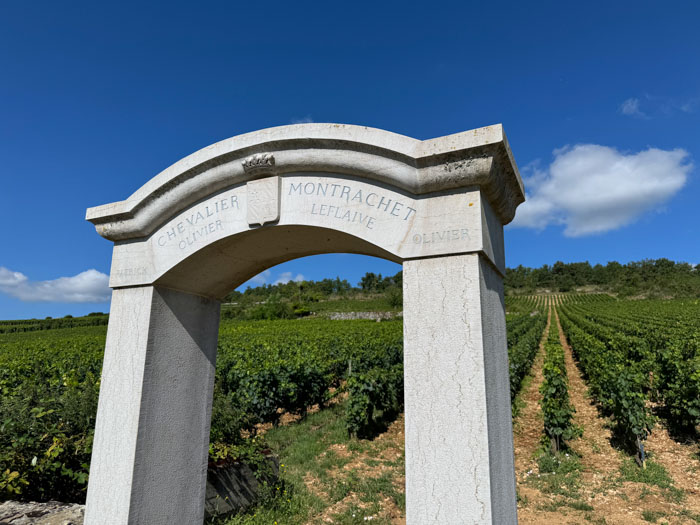
Then I met Patrick Leflaive, Olivier’s brother and half owner of the company. He and his brother branched off from his famous Uncle Vincent’s business 40 years ago, which was strongly focused on Puligny-Montrachet, wanting to produce wines from various areas of the Côtes de Beaune outside the town. Marketing pressure induced them to also do a Chablis and several Champagnes, the latter of which are produced near Epernay. His largest export customer is the US; only 30% of his wines are consumed in France. He took me on a tour of the Cave, which is actually an air-conditioned above-ground winery. Puligny-Montrachet has a very shallow water table, so there are no cellars here. (Millions of years ago, this area was a lake, which gives meaning to the name Puligny.) We went into considerable detail about the wine production practices. One difference in my experience is that they ferment (both alcoholic and malolactic) in oak barrels, whereas a California winery would use steel vats and then transfer into oak. They process whites from 82 appellations, so individual barrels is the only real solution. On the red side, it is a much smaller operation (20%? It’s hard to take notes while you’re conversing one on one), but we went into the details of production here as well.
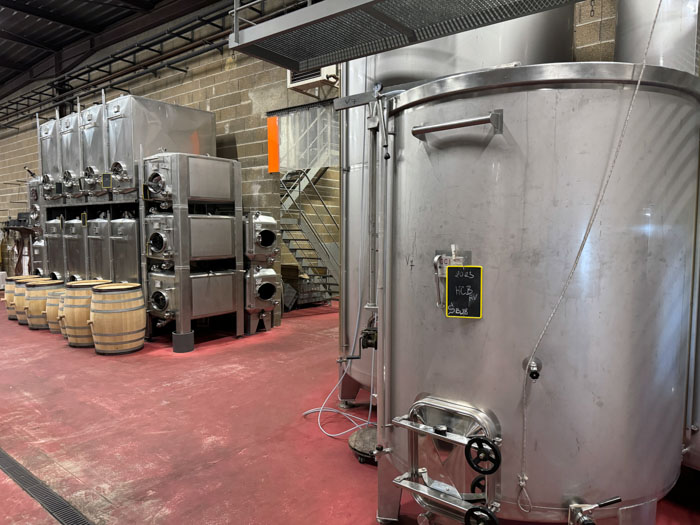
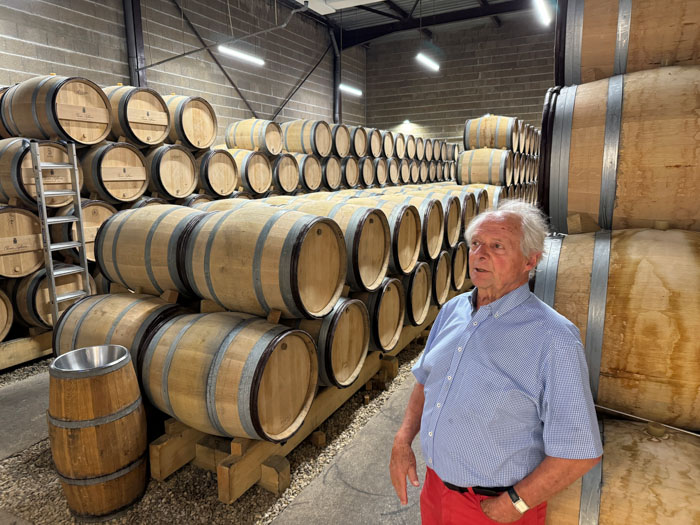
I really enjoyed conversing with Patrick, who is quite funny. He talked about his trips to San Francisco and Sonoma Valley and we exchanged opinions about differences in wine styles. (He had amusing insights into Merry Edwards’s Russian River Pinot Noirs and his erstwhile competitors in Bordeaux.) And since I have a World War II interest, I asked him about the German occupation in Burgundy. He said it was not a big problem except that the Germans drank a lot of wine and didn’t pay for any of it. They did not molest the locals much because they relied on them to produce the wine.
Back at the Olivier hotel, I had a nice lunch of duck breast with vegetables, cheese, and dessert, with a tasting of seven wines. Mateo returned to provide tasting commentary. First, two champagnes that I can’t say were too distinguished. Then three whites: a Puligny-Montrachet villages, a Saint-Aubin 1er Cru Dents de Chien (dog’s teeth, named after the peculiar stones in the vineyard), and a Chassagne-Montrachet Houillères. I particularly liked the Saint-Aubin. And two reds: a Pernand-Vergelesses villages and a Volnay 1er Cru Clos des Angles; I preferred the former.
Then I hiked south about one and a half miles to the Château de Chassagne-Montrachet (Domaines Famille Picard). It was a beautiful walk through the vineyards, a lot next to Grand Cru Bâtard-Montrachet, but temps in the upper 80s take their toll and my Achilles tendon is starting to be painful. I took a brief look at their 14th century cellar—refreshingly cool but with Middle Ages headroom—and then had a tasting. All of the wines here are from properties owned by the domaine. First was a ‘19 Saint-Aubin 1er Cru from the village on the other side of the Côte de Beaune. It was quite light and refreshing. Next a ‘22 Chassagne-Montrachet villages, more substantial. Then a ‘19 Chassagne-Montrachet 1er Cru Les Vergers, very nice with strong mineral notes. Onto the reds: ‘20 Mercurey 1er Cru Champs Martin (from the Côte Chalonnaise), a light wine that my host said would be a good picnic wine, but I thought it had more character than that. A ‘20 Chassagne-Montrachet villages was excellent and would go with many meals. Finally, a ‘16 Corton Grand Cru Clos des Fietres, which was coincidentally from right across the street from Senard yesterday in Aloxe-Corton. Excellent with a touch of tannin and a beautiful nose. My host suggested that light tannins are perfect compliments to soft cheeses, which is something I had not heard before. He also tried to sell me on rabbit braised in local reds. Probably not for me.

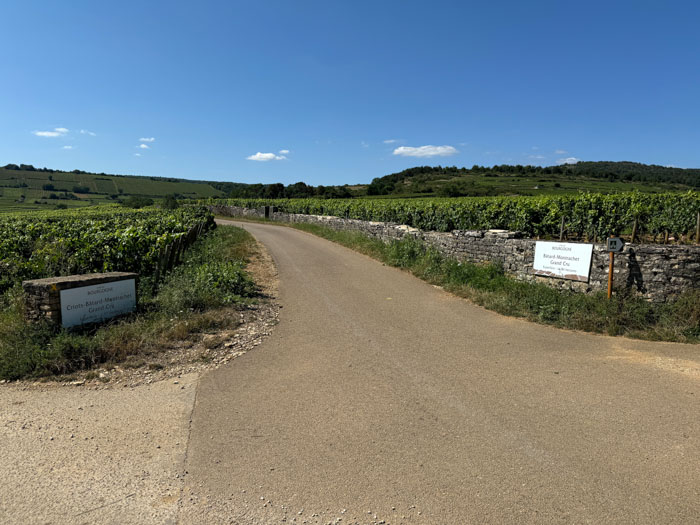
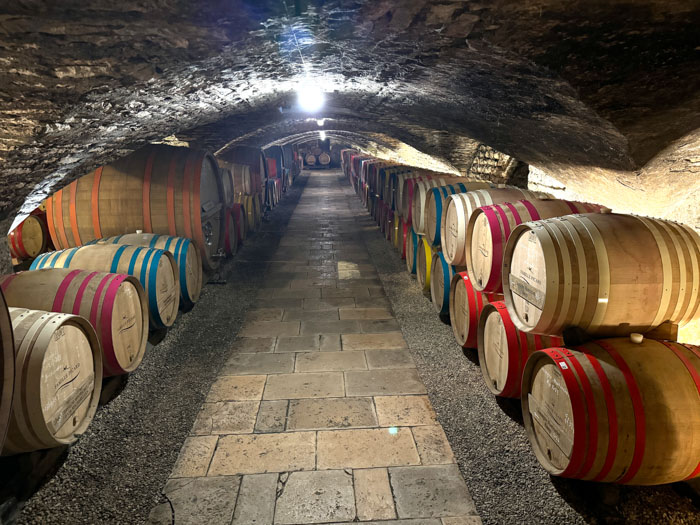
My final trial of the day was about three miles to the village of Santenay to meet my car pickup. Another very picturesque walk on hilly back roads through the vineyards, almost entirely Premier Crus, but the oppressive heat dampened my attention (and soaked my shirt!). In addition to that, my Achilles tendon is starting to become painful and I will probably need to adjust my schedule for the next two days. Dinner was outside at the hotel again—I was assured that no restaurants in Beaune were available on Saturday without a reservation and unfortunately I had not planned ahead by asking Grape Escapes to recommend dinner restaurants in Beaune and reserve in advance.
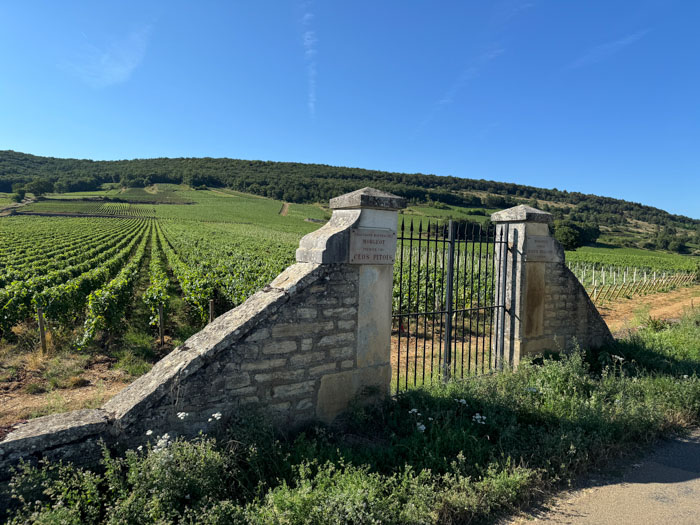
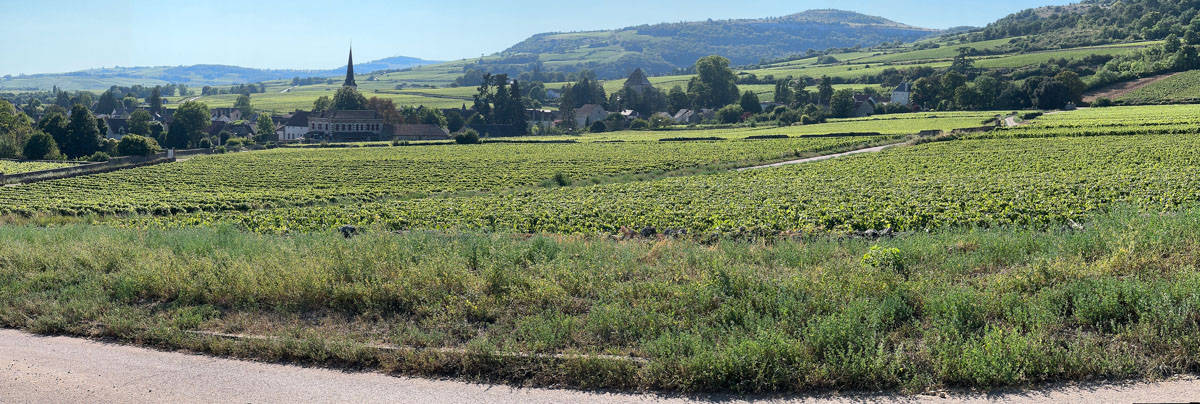
Sunday, August 11 — Beaune, Meursault
I have a different driver today (Fred!) who speaks excellent English, so I worked out schedule changes to remove the two long hikes for today and tomorrow. He drove me to Château Meursault in the Côtes de Beaune town of that name. Having a big château in Burgundy is rather unusual, unlike Bordeaux or Loire, and this one is large and imposing. The main building is from the 18th century, but the cellars date back to the 12th. All of the domaine’s production comes from properties they own, which is unusual for an estate that produces as many as 300K bottles. I learned about the Climats de Bourgogne, which is a recent UNESCO World Heritage designation that protects the historic vineyards. My guide was a delightful young woman named Clotilde who led me through the cellars and then conducted an excellent tasting of nine wines. For the first time in my life of wine tasting we started with reds. Clotilde explained that the following whites would be more sophisticated and we didn’t want to end the tasting with tannins in our mouths.
Reds: a ‘20 Ladoix Les Chaillots, a basic Bourgogne classification, which I found rather rough and acidic. ‘18 Beaune 1er Cru Toussaints, pleasant. ‘18 Pommard 1er Cru Clos de la Platière, really good, could use a few years. ‘17 Beaune 1er Cru Teurons, from a difficult year, was excellent, very light and balanced in the historic Burgundy style. Clotilde said that in Burgundy they have a saying that there are good years and then years in which more aging is needed.
Whites: ‘21 Bourgogne Clos du Château, light and refreshing. ‘21 Meursault du Château, a Villages, and then the ‘22 vintage of the same. Both were balanced and a little buttery, the latter from a better harvest more so than the former. Finally ‘21 Meursault 1er Cru Charmes-Dessus, which was a perfect specimen of a classic Meursault. As a bonus tasting, Clotilde let me sample their Marc du Bourgogne, an eau-de-vie that is processed from pomace similarly to Italian grappa, but this was aged for 15 years in oak, so it was a light brown color and super smooth despite being 84 proof. (It’s interesting that Clotilde had no knowledge of the word proof. She said 42 degrees.)
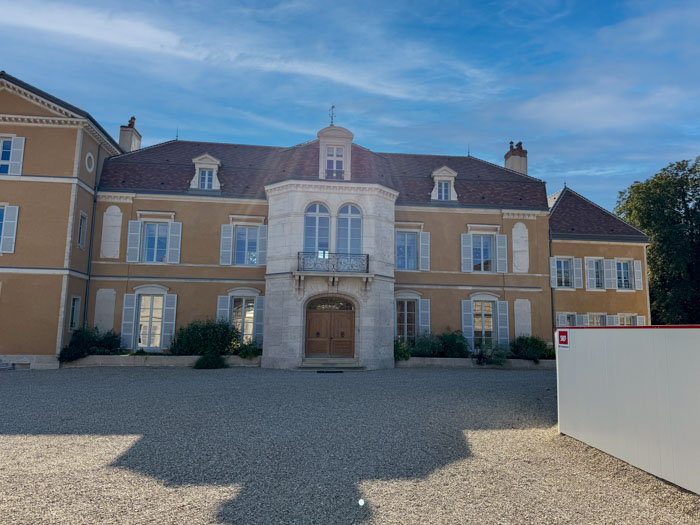
Lunch downtown at the Le Globe Hotel, about a half mile walk/limp. The center of Meursault is obviously more tourist-focused than the other villages I’ve visited so far, with lots of cafes. Lunch was lovely on the patio. The wine list was interesting because they have corkage fees that vary based on the level of classification—Grand Crus are much more expensive to uncork. Their selection by the glass was quite limited, but I had a very nice 2018 Auxey-Duresses. Lunch was not included in my Grape Escapes tour price; I had a prix-fixe “Marché” menu with an amuse bouche, gazpacho, (very rare) duck breast, and an exotically deconstructed lemon meringue pie.
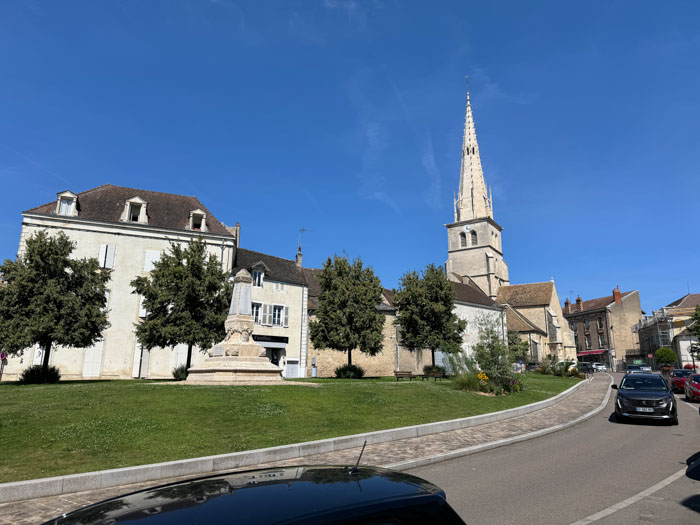
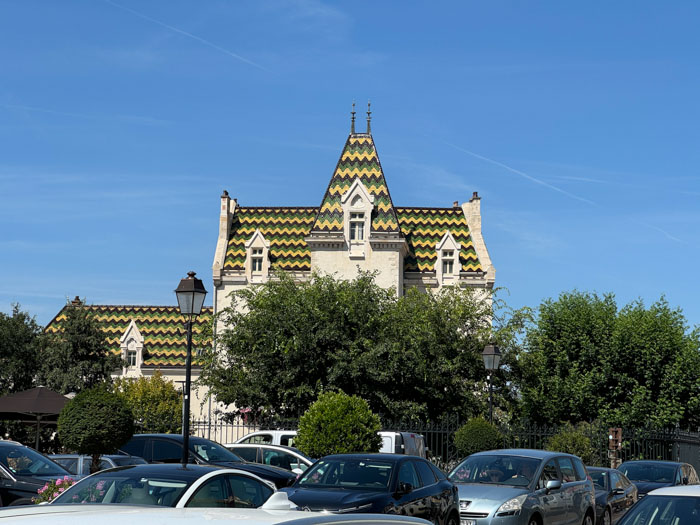
We drove to the Château de Pommard, my second Burgundy château. They have a very small production (200 cases) from plots on their estate and more from grapes purchased around the Côte D’Or. All organic, going as far as forsaking tractors for work horses. Almost no exporting, relying on visitors buying here or ship. My guide, Xavier, talked a lot about differences in elevation, showing glass cylinders with representative soil samples from each, with more limestone as you go higher. But these differences are for really shallow elevation changes, no more than tens of meters across the property. I tasted four reds, all Villages classification, which they label as Pommard Clos Marley-Monge and then the plot name. The first three were 2020 from three different elevations: Vivant Micault (lowest), Grands Esprit, and Chantrerie (highest) were all pleasantly drinkable and pretty similar, but they became slightly more sophisticated from low to high. The fourth, ‘19 Monopole, was a blend of three separate parcels, including their most exclusive, Simone (which bottled alone is 300€). It was nicer than the previous three, but not an awful lot.
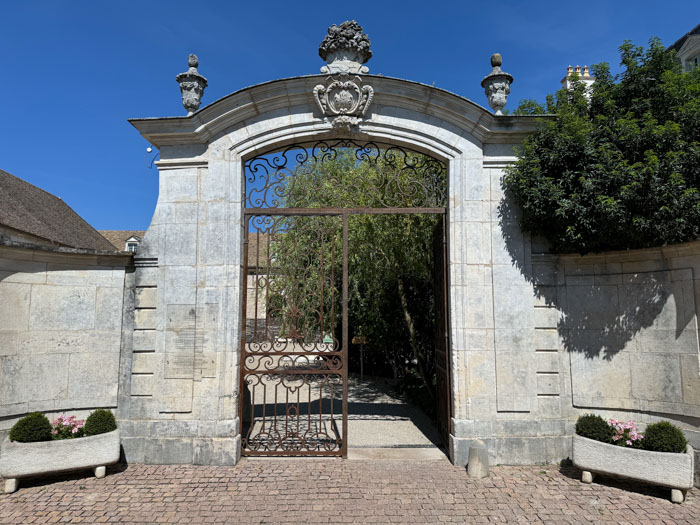
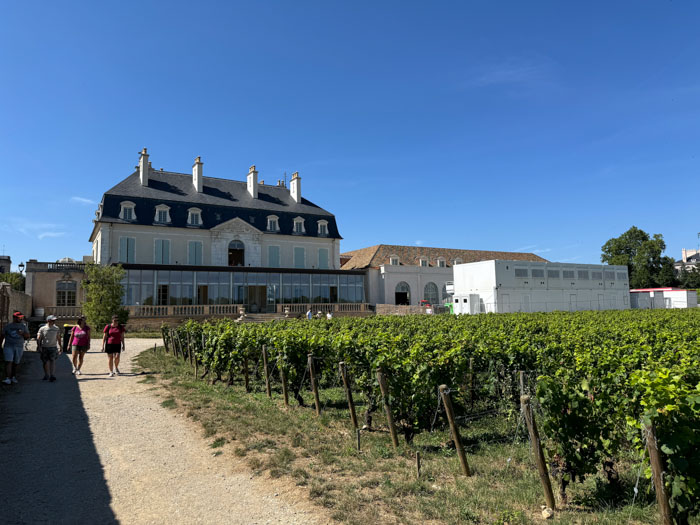
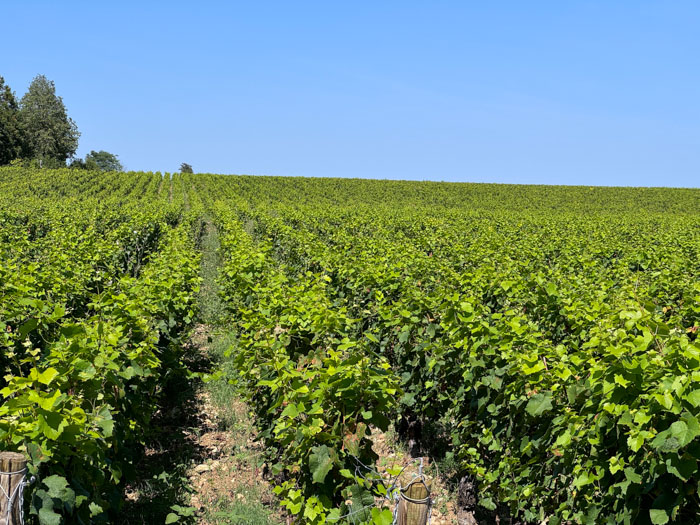
My final stop was back in the town of Beaune, Cave Patriarche. This is possibly the most famous of all the Burgundian negotiant/eleveurs, in operation since 1780. There is a self guided tour that winds through the labyrinthine low headroom cellars in which 3 million bottles are stored. There was a tasting of three minor white wines that I found uninteresting, but when I got to the next room that had three red wines, it was so crowded with tourists that I couldn’t get anyone to pay attention to me and I abandoned ship. This was my only low point of the tour so far. Then I walked across town back to my hotel. On the way, I stopped for nostalgic reasons to photograph the famous Hospice de Beaune (Hôtel-Dieu). In the fall of 1978 I attended a gala dinner here hosted by the Confrérie des Chevaliers du Tastevin and tasted the infant vintage right out of the barrel. For dinner my hotel found a brasserie with an open table, Le Monge. Not too good.
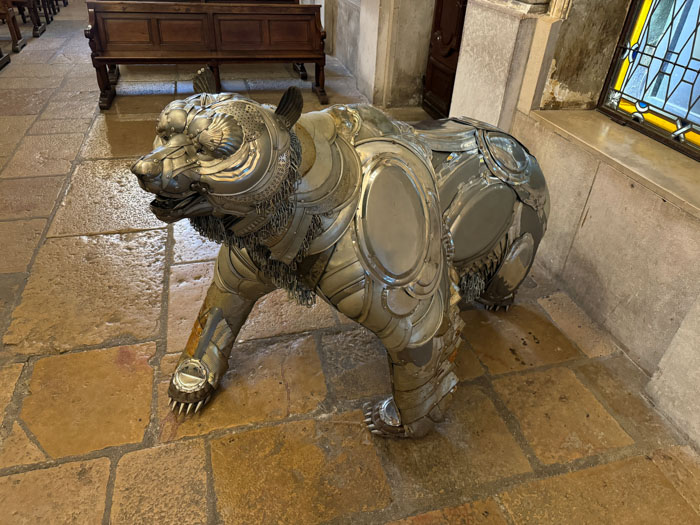
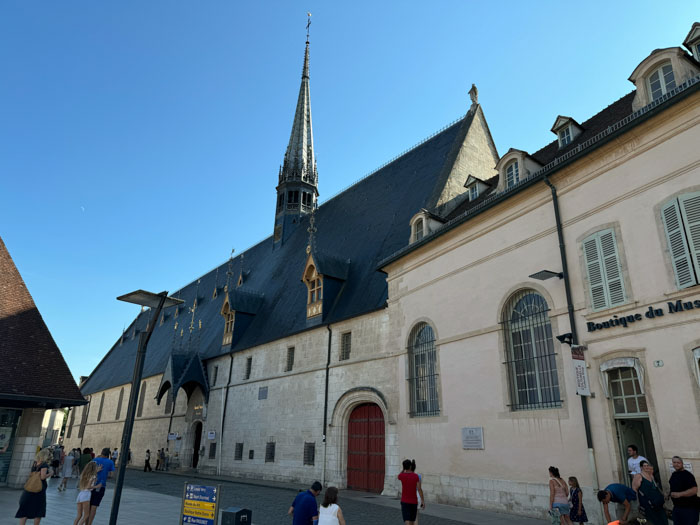
Monday, August 12 — Beaune, Côte de Nuits
I’ve spent three days in the Côte de Beaune, and now I will travel through its northern sister. My original itinerary was to taxi to Gevrey-Chambertin and then walk five miles south to Vosne-Romanée, but I changed the reservation to eliminate the walk and give my tendon a break. My regret about this is I am missing a chance to see the famous Clos de Vougeot, but I have included an internet photo. What I have seen so far is that the Côte de Nuits seems to be more built up commercially than its southern counterpart. My first stop is Domaine Armelle et Bernard Rion in Vosne-Romanée. This is a small family owned winery that has only about 12 hectares scattered throughout the area, but mostly Côte de Nuits. They like to specialize is really old vines, 80–120 years. Eighty percent of their wines are red. The name of the firm was once Bernard Rion, but his wife Armelle said she did a lot of work, too, so they added her name. However, inside the winery and on labels, only Bernard’s name appears. I was hosted by one of Bernard’s three daughters (whose name I missed, alas) and two friendly German gentlemen came along to form a little group.

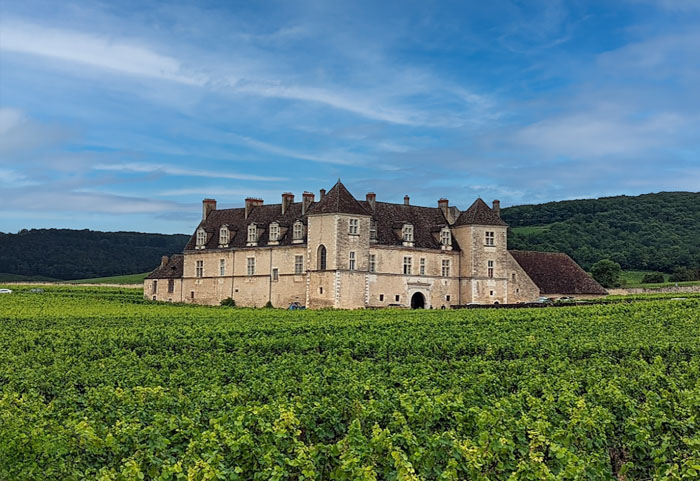

Every winery I’ve visited has different techniques and this one was no exception. They ferment their reds in concrete vats, which is rather typical of other regions. For our tasting, we started with a white, a regional ‘21 Bourgogne labeled Chardonnay, which was light and refreshing but undistinguished. The rest were reds. A ‘22 Pernand-Vergelesses Les Boutières Villages was pleasant, but a bit acidic. A ‘21 Chambolle-Musigny Les Echezeaux Villages (not be confused with the nearby Grand Cru Èchezeau) had nice body and was very balanced. A ‘21 Volnay 1er Cru was really nice with a sophisticated nose and long finish. I had a similar reaction to the ‘22 Nuits-Saint-Georges 1er Cru Marcel Héritage, but it had qualities that you might mistake for a Côte du Rhône. Finally, from deep in the family’s personal cellar, we had a 1986 Clos-Vougeot Grand Cru, which I thought was over the hill—diminished color (the color of a Burgundy roof, our host said), thin. It could be that vilification techniques have changed in forty years. Or the climate. Disappointing.
Right across the street is Hôtel Le Richebourg where I had a three-course lunch that was elegantly composed and delicious: salmon tartar, shrimp risotto, and a peach duo for dessert. Unfortunately, it did not include wine from the Grand Cru vineyard of the same name, certainly not by the glass. But I enjoyed a Nuits-Saint-Georges Villages red. Their main wine list had a number of four-figure bottles.
Next a mile walk south to the town of Nuits-Saint-Georges and my appointment at Caveau Moillard. Here I shared the services of our host Olivier with an affable Dutchman. I got along well with Olivier because he was almost as tall as I am and also spent about four years in the San Francisco Bay Area. We had a brief tour of the winery and Olivier went into detail about the production process. The facility is quite modern and they use all stainless steel for fermentation. There were six wines for tasting (plus one bonus) and Olivier let me decide the ratio of white to red. I chose one white, which was a ‘22 Pernand-Vergelesses, a light refreshing minor Chardonnay. Then all reds. A ‘20 Morley-Saint-Denis Villages, which I thought was rather rough and strong, not my typical Pinot Noir. A ‘19 Fixin 1er Cru Clos du Chapitre was excellent, smooth and fruity. Olivier said that Napoleon had two favorite wines, one Le Chambertin, the other Fixin. A ‘17 Nuits-Saint-Georges Villages was good, but the ‘18 Nuits-Saint-Georges 1er Cru Les Crots was excellent. The ‘17 Clos de Vougeot Grand Cru was really good, although it needed more aging and from a cost standpoint, the preceding is a better deal. Finally the bonus: a ‘20 Hospice de Beaune 1er Cru Cuvée Nicolas Robin, a blended wine that was just superb.
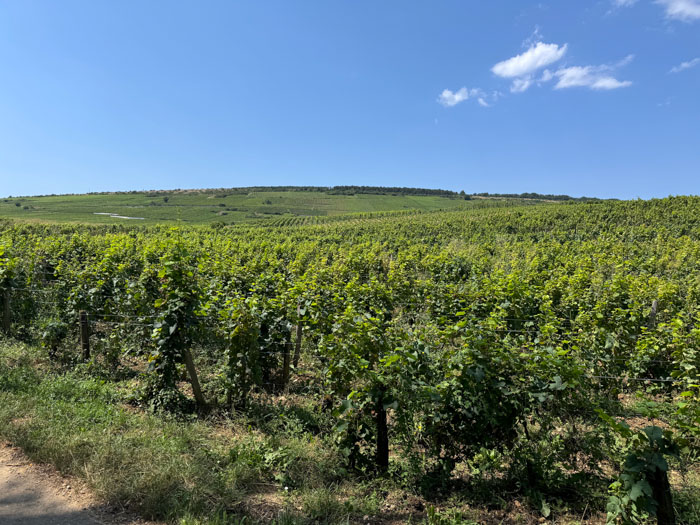

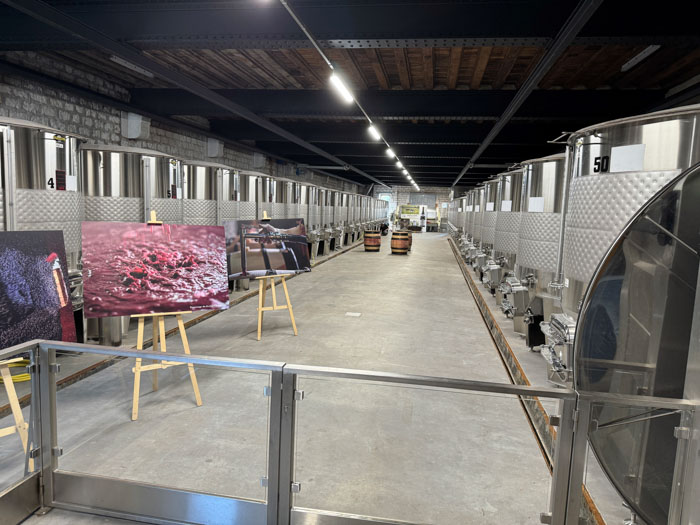
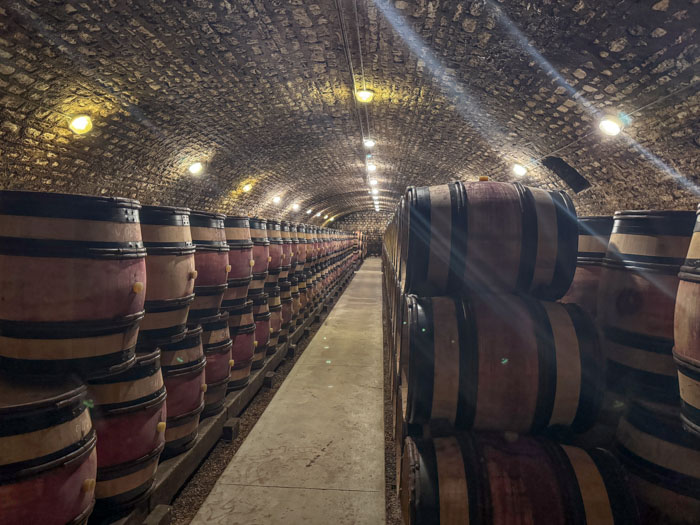
The car service returned me to the city of Beaune and the cellars of Joseph Drouhin, one of the most famous (and reliable) wine producers and negotiants in Burgundy. I was afraid that this might be as uninteresting as Patriache was yesterday, but that was certainly not the case. Since I was early, I browsed through the gift shop where they had a very large selection of wine on sale, including some wines from their Oregon branch (which I have consumed in the past and they are excellent). I have included a photo of one pricey row and another of a 15 L bottle! Our hostess Laurene led a group of a beautiful young Russian woman, an affable Irish couple, and me through the cellars that date back to the 13th century and the Dukes of Burgundy. There was one chamber in which there was a wall built by the Romans in 200 AD. There was also a grape press from 1570 that Robert Drouhin restored and it has been used for a few modern wines. (Robert was the nephew of Joseph’s son and did more to expand the company than anyone else. He is currently 91 and his children are running the private company.)

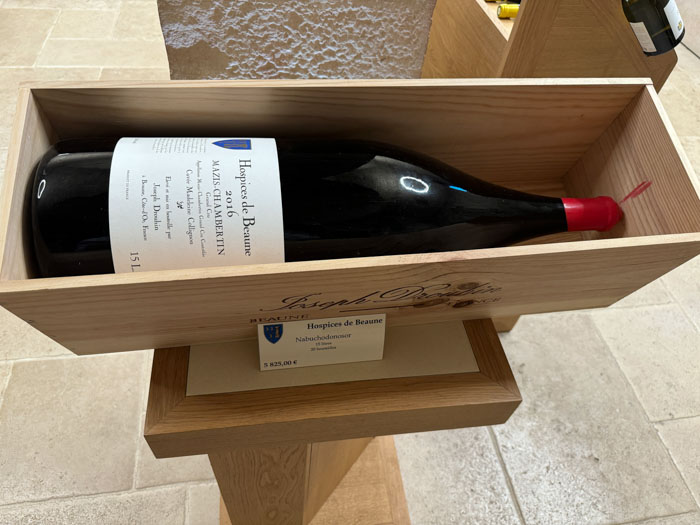

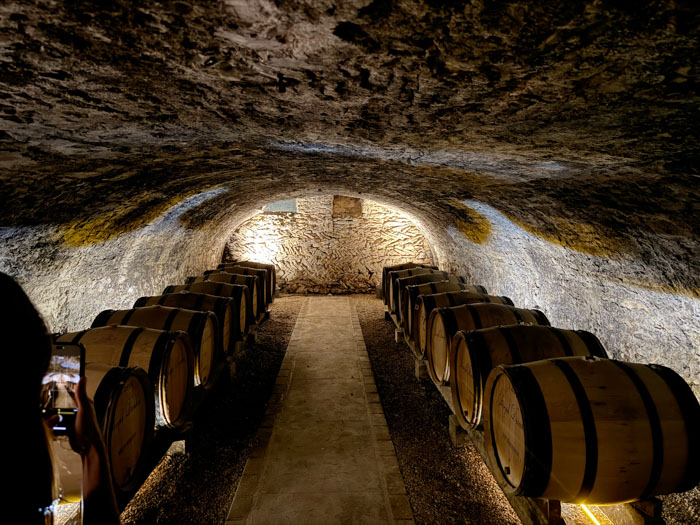


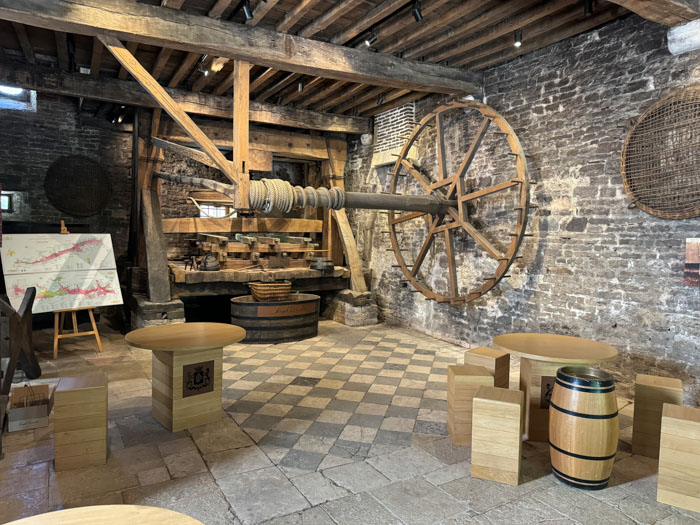
We tasted six wines in the cellar. Three whites: ‘22 Chablis 1er Cru Mont de Milieu was a typical Chablis, fresh and minerally. ‘20 Côte de Beaune, a Villages, was well-balanced, a pleasant wine ready for seafood. ‘20 Meursault 1er Cru La Pièce sous le Bois was the best of the bunch. Three reds: ‘19 Volnay (Villages) was a good drinkable Pinot Noir. ‘21 Beaune Clos des Mouches, Drouhin’s signature wine from its largest vineyard, was quite light and fruity. ‘21 Vosne-Romanée 1er Cru was a blend from two of their adjacent vineyards. It was the most sophisticated of the wines consumed here, with good balance, low tannins, and a long finish.
Back at the hotel, I once again could not find an available restaurant nearby, so I bought a baguette sandwich at a local boulangerie.
I had an excellent time on my Grape Escape. Kudos to my personal travel coordinator, Nicola Goldsmith, who was always available to answer questions. I will definitely consider future trip with them for another wine region. Maybe Tuscany?
Tuesday, August 13 — to Marseille
I took an early train to Lyon, connecting to Marseille for my military history tour of Operation Dragoon. You can read about that in a separate report, here.